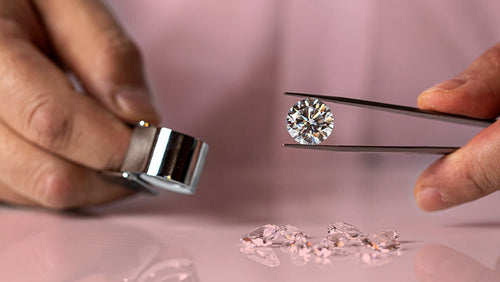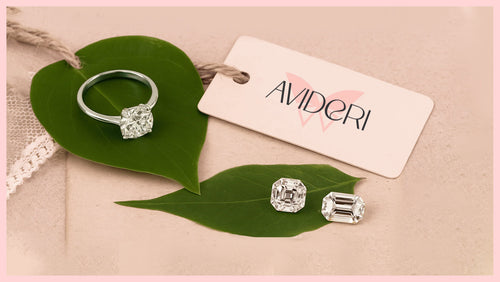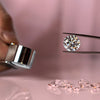Table Of Contents
- Lab-Grown Diamonds: Sustainability Concerns
- Are Lab-Grown Diamonds More Sustainable Than Mined Diamonds?
- Are Lab-Grown Diamonds Bad for the Environment?
- Are Lab-Grown Diamonds Good for the Environment?
- Industry Efforts Toward Greener Lab Diamonds
- Final Verdict: Are Lab-Grown Diamonds Sustainable?
- FAQS
As people become more aware of the environment, they are making more choices about what to buy. This has made the jewelry industry come under more scrutiny, especially when it comes to where the stones come from. For a long time, traditional diamond mining has been linked to land degradation, high energy use, water contamination, and worries about the ethics of how workers are treated. In response, Are Lab-Grown Diamonds Sustainable has become a viable alternative that is typically sold as a cleaner, greener, and more moral choice.
Synthetic or man-made diamonds, also called lab-grown diamonds, are manufactured in controlled lab conditions using either High Pressure High Temperature (HPHT) or Chemical Vapour Deposition (CVD) processes. These stones are the same physically and chemically as mined diamonds, yet they don't need the same complicated extraction methods.
Lab-Grown Diamonds: Sustainability Concerns

Even though lab-grown diamonds are often marketed as a more environmentally friendly option than mine stones, there are still key environmental issues that need to be thought about. The quantity of energy needed to make these stones is at the heart of these worries. To make a diamond in a lab, you have to recreate the very harsh circumstances in which natural diamonds originate. This can be done using either High Pressure High Temperature (HPHT) methods or Chemical Vapour Deposition (CVD).
Both approaches need a lot of energy. HPHT, on the other hand, needs a lot of heat and pressure, which means it needs a lot of electricity. People frequently think that CVD is a better way to save energy; however, it still uses energy all the time, especially when making bigger or better stones.
The environmental impact of a lab-grown diamond depends a lot on where the energy comes from. When fossil fuels like coal or natural gas are the main sources of power, the process of making electricity can release a lot of greenhouse gases. In some situations, lab-grown diamonds made with power from coal may have a carbon footprint that is as high as or higher than that of sustainably mined stones.
Are Lab-Grown Diamonds More Sustainable Than Mined Diamonds?

There is no easy answer to the question of whether lab-grown diamonds are better for the environment than mined diamonds. Both choices have their own effects on the environment and ethics, and how and where they are made has a big impact on how long they last.
From an environmental point of view, lab-grown diamonds do away with the necessity for large-scale mining, which is often linked to major land disruption, habitat destruction, soil erosion, and water pollution. When diamonds are mine in the traditional way, especially in open-pit and alluvial forms, a lot of dirt is taken away.
The use of heavy machinery causes a lot of carbon emissions and damage to the environment over time. Mining can also cause forests, move people from their homes, and destroy the biodiversity of nearby ecosystems. Lab-grown diamonds, on the other hand, are made in control lab settings and don't involve digging up the earth.
Are Lab-Grown Diamonds Bad for the Environment?

People often say that lab-grown diamonds are good for the environment, yet they do have certain negative effects on the ecosystem. One of the main complaints is that they use a lot of electricity. To make diamonds in a lab, especially using the High Pressure High Temperature (HPHT) method, you need a lot of energy to make the circumstances in the lab like those in nature. If this energy comes from fossil fuels, which is commonly the case in nations with coal-heavy grids, the carbon impact can be very high.
Another worry is the reliance on industrial infrastructure. Diamonds grown in labs are made in high-tech facilities that use specialized equipment, cleanroom settings, and complicate chemical procedures. This large-scale production uses up resources and raises the total cost to the environment.
Also, getting rid of e-waste and chemicals raises worries about how long things will last. The machines used to grow and process diamonds don't last very long, thus they could create electronic waste. Also, the gasses and chemicals used in the CVD process can be dangerous if they aren't handled or thrown away correctly.
Are Lab-Grown Diamonds Good for the Environment?

For good reason, lab-grown diamonds are often thought to be better for the environment than mine diamonds. One big plus is that they don't destroy habitats. When you mine in the traditional way, it can cause deforestation, soil erosion, and the loss of animals. However, lab-grown stones are made in controlled circumstances, so they don't harm natural ecosystems.
Also, diamonds created in a lab don't pose a risk of contaminating groundwater. Mining often uses chemicals that are bad for people and animals and can get into water sources. Making stones in a lab, on the other hand, doesn't make any of these harmful by-products at all.
The possibility of using renewable energy is another benefit for the environment. Some modern labs now run on solar or hydropower, which cuts down on the amount of carbon they put into the air. Not all producers have made the changeover yet, but the industry is moving toward more environmentally friendly ways of doing things.
Industry Efforts Toward Greener Lab Diamonds
A lot of companies that make lab-grown diamonds are trying hard to have less of an impact on the environment. Some of them are using solar and wind energy to power their factories, which cuts down on carbon emissions a lot. Some people have gotten carbon-neutral certification by using eco-friendly methods and making up for their emissions through verified programs.
Innovation is also leading to more environmentally friendly ways of making things, such systems for recycling water and better ways to grow things. As people learn more about the issue, the industry is putting money into more environmentally friendly options to make sure that lab-grown diamonds stay a good choice.
Final Verdict: Are Lab-Grown Diamonds Sustainable?

There are evident environmental benefits to lab-grown diamonds, such as no mining, less habitat destruction, and the possibility of using renewable energy. But they don't have any influence at all, since some production still uses fossil fuels. Long-term sustainability hinges on continuing to come up with innovative ideas and getting more people to use renewable energy.
In the end, consumers also have a part to play. You may make more changes by choosing certified, responsibly made stones and backing firms who are open about their practices. Lab-grown diamonds aren't ideal, but they are a good start toward a jewelry sector that cares more about the environment and people.
FAQS
1. Are lab-grown diamonds really better for the environment?
Yes, they generally have a smaller environmental footprint compared to mined diamonds. They avoid habitat destruction and groundwater pollution, and can be produced using renewable energy.
2. Do lab-grown diamonds use a lot of energy?
They do require significant energy, but many companies are transitioning to solar and wind power to reduce carbon emissions.
3. Can lab-grown diamonds be certified as sustainable?
Yes. Some producers are certified carbon-neutral and follow sustainable practices, such as water recycling and clean energy use.
4. Are all lab-grown diamonds eco-friendly?
Not all. It depends on the producer’s energy sources and environmental policies. It's best to choose stones from transparent, sustainability-focused brands.
5. What can consumers do to make a more sustainable choice?
Look for certifications, ask about energy sources, and support companies that prioritise eco-friendly production.







